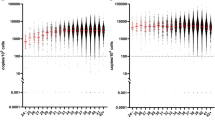Abstract
In the present study, we sought to identify the factors during the pregnancy of systemic lupus erythematosus (SLE) patients that could be linked to the presence and proliferation of male fetal cells (MFC) and the possible relation between these factors and development of lupus nephritis (LN). We evaluated 18 healthy women (control group) and 28 women affected by SLE. Genomic DNA was extracted from peripheral blood and quantified using the technique of quantitative real-time polymerase chain reaction (qPCR) for specific Y chromosome sequences. The amount of MFC was significantly higher in the SLE group compared with the controls (SLE 252 ± 654 vs control 2.13 ± 3.7; P = 0.029). A higher amount of MFC was detected among multiparous SLE patients when compared with the control group (SLE 382 ± 924 vs control 0.073 ± 0.045; P = 0.019). LN was associated with reduced amount of MFC (LN 95.5 ± 338 vs control 388 ± 827; P = 0.019) especially when they have delivered their child before age 18 (LN 0.23 ± 0.22 vs control 355 ± 623; P = 0.028). SLE patients present a higher amount of MFC, which may increase with the time since birth of the first male child. LN patients showed an inverse correlation with MFC, suggesting that the role of the cells may be ambiguous during the various stages of development of the disease.
Similar content being viewed by others
Abbreviations
- LN:
-
Lupus nephritis
- SLE:
-
Systemic lupus erythematosus
- FM:
-
Fetal microchimerism
- MFC:
-
Male fetal cell
- ACR:
-
American College of Rheumatology
- qPCR:
-
Quantitative polymerase chain reaction
- SRY:
-
Sex-determining region Y
- MCF/mL:
-
Male fetal cell per milliliter
References
Riemekasten G, Hahn BH (2005) Key autoantigens in SLE. Rheumatology 44:975–982
Jacobsen S, Petersen J, Ullman S, Junker P, Voss A, Rasmussen JM et al (1998) A multicenter study of systemic lupus erythematosus in 513 Danish patients. I: disease manifestations and analyses of clinical subsets. Clin Rheumatol 17:468–477
Cervera R, Khamasthta MA, Font J, Sebastiani GD, Gil A, Lavilla P et al (1993) Systemic lupus erythematosus: clinical and immunological patterns of disease expression in a cohort of 1000 patients. Medicine 72:113–124
Bianchi DW, Zickwolf GK, Weil GJ, Sylvester S, DeMaria MA (1996) Male fetal progenitor cells persist in maternal blood for as long as 27 years postpartum. Proc Natl Acad Sci U S A 93:705–708
Lee TH, Paglieroni T, Ohto H, Holland PV, Busch MP (1999) Survival of donor leukocyte subpopulations in immunocompetent transfusion recipients: frequent long-term microchimerism in severe trauma patients. Blood 93:3127–3139
Kremer Hovinga IC, Koopmans M, Baelde HJ, van der Wal AM, Sijpkens YW, de Heer E et al (2006) Chimerism occurs twice as often in lupus nephritis as in normal kidneys. Arthritis Rheum 54:2944–2950
Abbud Filho M, Pavarino-Bertelli EC, Alvarenga MP, Fernandes IM, Toledo RA, Tajara EH et al (2002) Systemic lupus erythematosus and microchimerism in autoimmunity. Transplant Proc 34:2951–2952
Tan EM, Cohen AS, Fries JF, Masi AT, McShane DJ, Rothfield NF et al (1992) The 1982 revised criteria for the classification of systemic lupus erythematosus. Arthritis Rheum 25:1271
Abdel-Rahman SZ, Nouraldeen AM, Ahmed AE (1994) Molecular interaction of [2,3-14C] acrylonitrile with DNA in gastric tissue of rat. J Biochem Toxicol 9:191–198
Heid CA, Stevens J, Livak KJ, Williams PM (1996) Real time quantitative PCR. Genome Res 6:986
Lo YM, Tein MS, Lau TK, Haines CJ, Leung TN, Poon PM et al (1998) Quantitative analysis of fetal DNA in maternal plasma and serum: implications for noninvasive prenatal diagnosis. Am J Hum Genet 62:768–775
Sarkar K, Miller FW (2004) Possible roles and determinants of microchimerism in autoimmune and other disorders. Autoimmun Rev 3:454–463
Adams KM, Nelson JL (2004) Microchimerism: an investigative frontier in autoimmunity and transplantation. JAMA 291:1127–1131
Stevens AM, McDonnell WM, Mullarkey ME, Pang JM, Leisenring W, Nelson JL (2004) Liver biopsies from human females contain male hepatocytes in the absence of transplantation. Lab Invest 84:1603–1609
Miyashita Y, Ono M, Ono M, Ueki H, Kurasawa K (2000) Y chromosome microchimerism in rheumatic autoimmune disease. Ann Rheum Dis 64:605–612
Gannagé M, Amoura Z, Lantz O, Piette JC, Caillat-Zucman S (2002) Fetomaternal microchimerism in connective tissue diseases. Eur J Immunol 32:3405–3413
Mosca M, Curcio M, Lapi S, Valentini G, D’Angelo S, Rizzo G, Bombardieri S (2003) Correlations of Y chromosome microchimerism with disease activity in patients with SLE: analysis of preliminary data. Ann Rheum Dis 62:651–654
Kremer Hovinga IC, Koopmans M, Grootscholten C, van der Wal AM, Bijl M, Derksen RH et al (2008) Pregnancy, chimerism and lupus nephritis: a multi-centre study. Lupus 17:541–547
Launay D, Hebbar M, Hatron PY, Michon-Pasturel U, Queyrel V, Hachulla E et al (2001) Relationship between parity and clinical and biological features in patients with systemic sclerosis. J Rheumatol 28:509–513
Wang Y1, Iwatani H, Ito T, Horimoto N, Yamato M, Matsui I et al (2004) Fetal cells in mother rats contribute to the remodeling of liver and kidney after injury. Biochem Biophys Res Commun 325:961–967
Authors’ contributions
GMSF and IMMF collected and assembled data, performed data analysis and interpretation, and helped to prepare the manuscript. HCC performed data analysis and interpretation, provided administrative support, and helped to prepare the manuscript. ECP and EMGB provided technical support and helped to prepare the manuscript. MAF was responsible for study conception and design, collection and assembly of data, data analysis and interpretation, manuscript writing, and final approval of the manuscript. All authors read and approved the final manuscript.
Author information
Authors and Affiliations
Corresponding author
Ethics declarations
The study was approved by the Institutional Ethics Committee of the medical school (number 0007/2000) in accordance with the current standards for human research, and informed consent of patients was obtained.
Disclosures
None.
Rights and permissions
About this article
Cite this article
da Silva Florim, G.M., Caldas, H.C., Pavarino, E.C. et al. Variables associated to fetal microchimerism in systemic lupus erythematosus patients. Clin Rheumatol 35, 107–111 (2016). https://doi.org/10.1007/s10067-015-3122-8
Received:
Revised:
Accepted:
Published:
Issue Date:
DOI: https://doi.org/10.1007/s10067-015-3122-8




